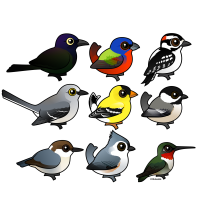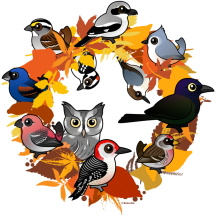Downy Woodpecker
About the Downy Woodpecker

The Downy Woodpecker is the smallest woodpecker in North America. Their breeding habitat is forested areas, mainly deciduous, across most of North America to Central America. They nest in a tree cavity, excavated by the nesting pair in a dead tree or limb. The Downy Woodpecker can also be found east of Newfoundland and Labrador, on the islands of Saint-Pierre and Miquelon.
These birds are mostly permanent residents. Northern birds may migrate further south; birds in mountainous areas may move to lower elevations. Downy Woodpeckers roost in tree cavities in the winter.
Downy Woodpeckers forage on trees, picking the bark surface in summer and digging deeper in winter. They mainly eat insects, also seeds and berries.

Find cute products & gifts with our Birdorable Downy Woodpecker
Details & Statistics
Added to Birdorable
Hatched August 5, 2007
Scientific Name
Picoides pubescens
Bird Family
Measurements
Length:
5.5 to 6.7 inches
(14 to 17 cm)
Wingspan:
9.8 to 11.8 inches
(24.9 to 30 cm)
Weight:
.7 to 1 ounces
(19.8 to 28.3 grams)
International Names

Chinese
绒啄木鸟

Czech
Strakapoud Osikový

Danish
Dværgflagspætte

Dutch
Donsspecht

Finnish
Keijutikka

French
Pic Mineur

German
Dunenspecht

Italian
Picchio Vellutato

Japanese
セジロコゲラ (Sejirokogera)

Norwegian
Dunspett

Polish
Dzieciol Kosmaty

Russian
Пушистый дятел

Spanish
Pico Pubescente

Swedish
Dunspett
























